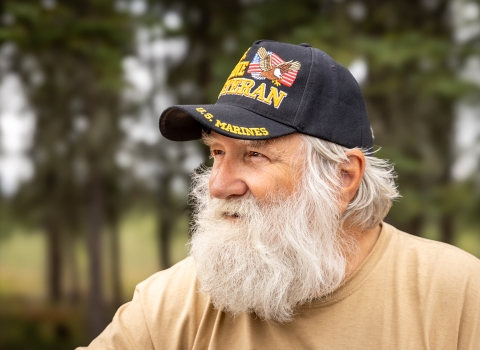A vacant lot transformed into a vibrant pocket park.
A fully sustainable reservation and Tribal center.
A 6.2-acre community park and garden.
A riverfront fortified by native trees, rain gardens, and restored wetlands.
This is what members of four unique Chesapeake communities envisioned when asked how green infrastructure could meet their needs.
Now, after a pilot initiative led by the Chesapeake Bay Program to address inequities in climate-change planning, their ideas are on track to becoming reality.
Leveling the playing field
Study after study has shown climate change takes the greatest toll on communities with the fewest resources to prepare and recover.
Yet these same communities also face the threat of “green gentrification,” when outside initiatives that aim to improve local climate resilience end up increasing property values, as well—forcing out residents with lower incomes.
The Chesapeake Bay Program’s Targeted Outreach for Green Infrastructure in Vulnerable Areas project, or TOGI, was conceived in response to these challenges.
Climate change includes both global warming driven by human-induced emissions of greenhouse gases and the resulting large-scale shifts in weather patterns. Though there have been previous periods of climatic change, since the mid-20th century humans have had an unprecedented impact on Earth's climate system and caused change on a global scale.
Learn more about climate change to develop green-infrastructure responses that meet local needs.
Co-led by the U.S. Fish and Wildlife Service's Science Applications program, U.S. Environmental Protection Agency and Chesapeake Research Consortium, TOGI partners with communities that have historically been excluded from conservation’s benefits to design projects that improve quality of life, increase climate resilience, and support priority habitat for fish and wildlife.
Now the Bay Program has released a report sharing the process behind the pilot project, including lessons-learned for practitioners who want to replicate the approach in other places.
“Climate change is transforming lands and waters that people and wildlife depend upon, with disproportionate impacts on communities that are most vulnerable,” said Chris Guy, the Service’s liaison to the Chesapeake Bay Program.
“Partnering with communities to address these complex issues is essential—successful partnerships start by bringing people together early to talk about their needs and concerns and continuing that dialogue throughout the process.”
Partnering process
The new report details the engagement process and outcomes for the project—from community selection, to planning, to design and next steps.
To identify focal communities in the watershed, the project’s steering committee—which included Chesapeake Bay Program employees and partners with expertise in habitat restoration, climate change, community engagement, and spatial data analysis—combined data on demographics, climate risk, and priority habitat for fish and wildlife.
The team selected four communities to partner with in the pilot effort: Cambridge, Maryland, on the Choptank River; the Virginia-recognized Mattaponi Tribe in the Middle Peninsula in the Tidewater area of Virginia; the federally recognized Upper Mattaponi Tribe in the Middle Peninsula in the Tidewater area of Virginia; and Williamsport, Pennsylvania, on the Susquehanna River.
With funding from the Chesapeake Bay Program, the project team worked with contractor Skeo Solutions to facilitate the engagement process, starting by inviting leaders in each community to lead local steering committees to help guide the work.
The project team then held a listening session in each community to hear from residents about opportunities to address vulnerabilities to climate change, support priority habitat for fish and wildlife, and meet local needs through green infrastructure.
Using feedback from the listening sessions, the project team worked with the local steering committee in each community to develop a set of green infrastructure design concepts, which were then presented to the community in a follow-up workshop.
The process resulted in the following community-driven, green infrastructure design proposals:
- Cambridge, Maryland: A community park on Leonards Lane that meets local needs for gathering, gardening and recreation, while enhancing natural beauty, water quality and ecological function through wetland restoration, bioretention structures, habitat gardens and other features.
- The Mattaponi Tribe: Riverbank stabilization along the Mattaponi River to reduce erosion and provide in-stream habitat to support aquatic species, particularly those with cultural importance to the Tribe, like American shad.
- The Upper Mattaponi Tribe: A sustainable development on a historical Tribal property that offers community gathering space, housing and recreational opportunities, as well as river access and recreational amenities on another property along the Mattaponi River.
- Williamsport, Pennsylvania: A community garden and park space on vacant lots owned by the University of Pittsburgh Medical Center, for use by hospital patients and community members, and enhancements to the streetscape along Little League Boulevard for beautification and public safety.
Conservation-ready
While the scope of TOGI did not include implementing designs, the project team committed to helping communities identify funding opportunities to bring their ideas to fruition.
Cambridge, Maryland, has received funding from the National Park Service to complete the design for the Leonards Lane Park.
Williamsport, Pennsylvania, has received a donation of land from the University of Pennsylvania Medical Center to expand the community garden, partnering with the Service’s Pennsylvania Field Office to create integrated pollinator gardens throughout.
The Mattaponi Tribe is implementing a living shoreline project through funds administered by the Virginia Department of Conservation and Restoration.
The Upper Mattaponi Tribe has received funding from the Chesapeake Bay Watershed Small Watershed Grants Implementation program, administered by the U.S. Environmental Protection Agency in partnership with the National Fish and Wildlife Foundation, to design and implement stream restoration on newly acquired reservation land.
Although the projects are moving forward in each of the communities, the Chesapeake Bay Program will continue to provide technical support until all four designs are fully realized.
It’s a model that TOGI partners hope will be adopted elsewhere.







